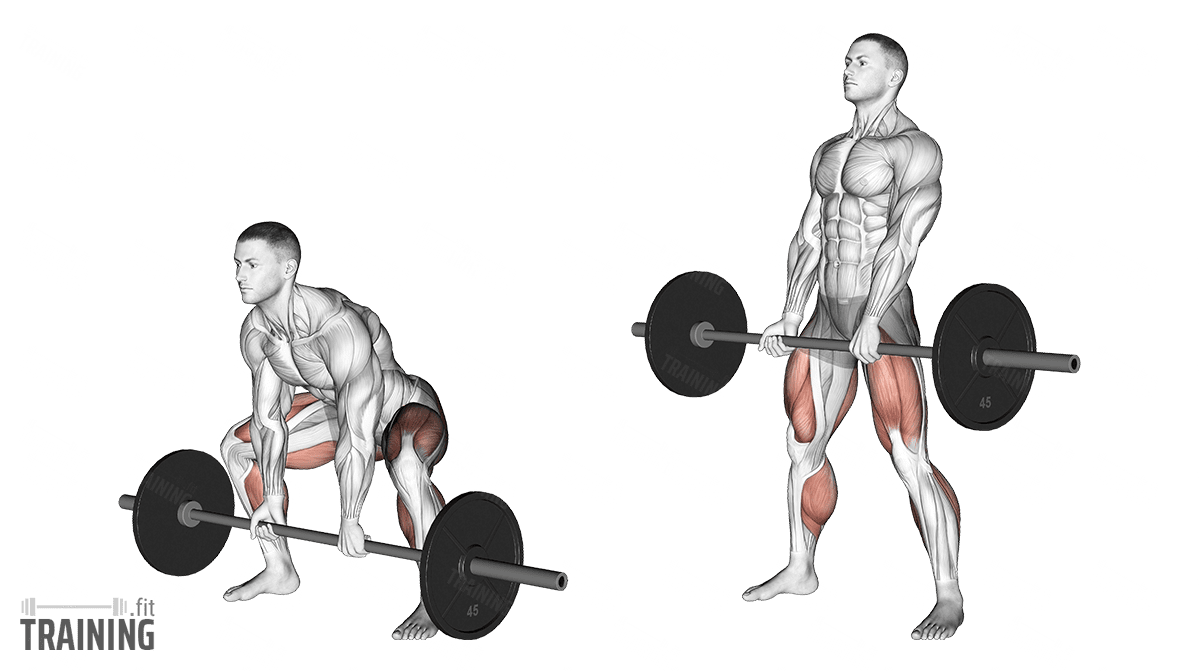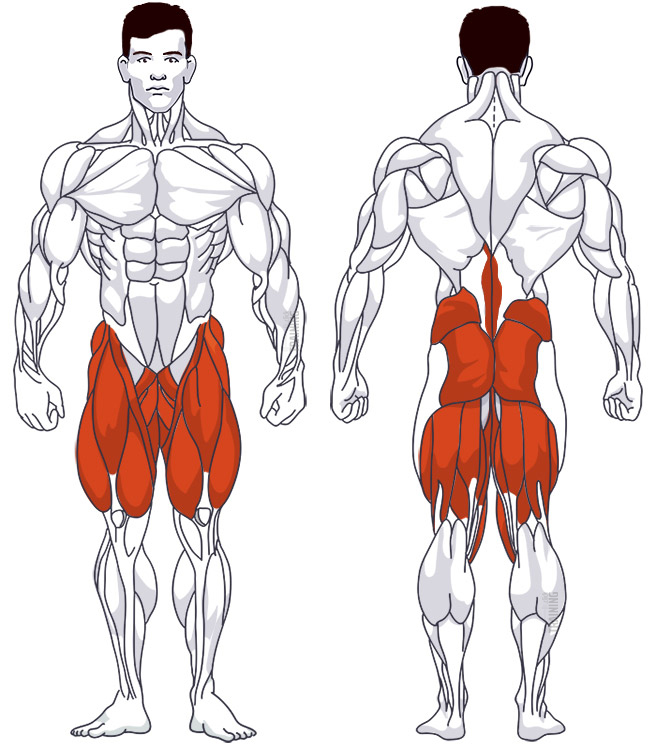Sumo Deadlift
Compound exercise, Free weightsOverview

Main muscles
- Thigh: Quadriceps
(Musculus quadriceps femoris) - Buttocks: Large gluteus maximus
(Musculus gluteus maximus) - Back: Back extensor
(Musculus erector spinae)
Training plans
Here you can find example plans for sumo deadlift training:
Sumo Deadlift: Basics and alternatives

Involved main muscle groups:
Sumo Deadlift
The Sumo Deadlift is a variation of the regular deadlift that stands out because of its wider foot stance. Just like the traditional deadlift, you’ll bend your upper body to lift the barbell from the ground and straighten your legs and back to stand up.
What makes the Sumo Deadlift unique is the shorter range of motion due to the wide stance and a shift in muscle focus towards the legs. As a result, your lower back experiences less stress compared to the classic deadlift, but maintaining proper form is still crucial to avoid injury.
Although the Sumo Deadlift can be daunting for beginners, it’s important to learn about different deadlift exercises. When done correctly, it can provide an excellent workout. If you’re not ready for the Sumo Deadlift, consider trying the dumbbell deadlift, the Romanian deadlift, Good Mornings (to focus on the lower back), or the back extension machine to help beginners prepare their lower back. Squats are also a great alternative for leg training.
Correct Execution
The Sumo Deadlift follows the same principles as the traditional deadlift, meaning a straight back is essential for a safe and effective workout. Before adding heavy weights, take time to perfect your form with the help of a trainer or by practicing in front of a mirror or recording yourself.
When performing the Sumo Deadlift, your feet should be wider than shoulder-width apart. There’s no set distance, but starting with a slightly wider stance helps avoid straining your hamstrings, lower back, and hips. Your toes should point in the same direction as your knees.
Video Tutorial
Step-by-Step Guide
With the barbell on the floor, stand in front of it with your feet slightly wider than shoulder-width apart. Stand close enough so your shins don’t touch the barbell, but your feet should be under it, around mid-foot height.
Bend your knees and hips, gripping the barbell firmly with both hands using an overhand grip about shoulder-width apart. Your arms should be inside your legs. Ensure your shoulders are directly above the bar and your hips are between your head and knees.
Maintain a minimal arch in your lower back, keeping the rest of your back straight. Align your head with your spine and hips. Tighten your core. You’re now in the starting position.
With straight arms, lift the weight off the floor by simultaneously straightening your legs and standing upright. Try to lift the barbell in a vertical line upward. From the side, the weight should move straight up without curving. Keeping the bar close to your shin (without touching it) works best for this.
Finish the movement by pushing your hips slightly forward, standing upright, and holding the bar in front of your hips. Don’t overarch your back. Hold this position momentarily.
Lower the bar back down by bending your legs and hips, returning to the starting position. You can put the weight down on the floor, but for more repetitions, maintain body tension and don’t relax it.
Avoiding Mistakes and Injuries
The Sumo Deadlift has the same potential for errors and injuries as the regular deadlift. So, make sure you pay attention to proper form to avoid straining your discs. This includes not curving your back. A rounded back with heavy weight in your arms puts a lot of strain on your spine and can lead to serious injury. That’s why it’s important to start with low weight and practice proper form in front of a mirror.
One way to ensure proper form is to lift the weight straight up. The bar should move vertically along your legs and not curve. You can achieve this by keeping the distance between the barbell and your body narrow (but without touching it).
There’s no perfect foot position for the Sumo Deadlift. Don’t let anyone tell you your toes must point forward. With a wide stance, your feet usually point outwards. Listen to your body and position your feet so that the weight doesn’t cause pain in your knees.